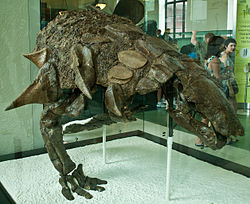Edmontonia rugosidens
|
Edmontonia Temporal range: Late Cretaceous, 76.5–69 Ma |
|
|---|---|
 |
|
| Mounted skeleton of E. rugosidens, specimen AMNH 5665 | |
| Scientific classification | |
| Kingdom: | Animalia |
| Phylum: | Chordata |
| Clade: | Dinosauria |
| Order: | †Ornithischia |
| Family: | †Nodosauridae |
| Genus: |
†Edmontonia Sternberg, 1928 |
| Species | |
|
|
| Synonyms | |
|
|
Edmontonia was an armoured dinosaur, part of the nodosaur family from the Late Cretaceous Period. It is named after the Edmonton Formation (now the Horseshoe Canyon Formation in Canada), the unit of rock it was found in.
Edmontonia was bulky, broad and tank-like. Its length has been estimated at about 6.6 m (22 ft). In 2010, Gregory S. Paul considered both main Edmontonia species, E. longiceps and E. rugosidens, to be equally long at six metres and weigh three tonnes.
Edmontonia had small, oval ridged bony plates on its back and head and many sharp spikes along its sides. The four largest spikes jutted out from the shoulders on each side, the second of which was split into subspines in E. rugosidens specimens. Its skull had a pear-like shape when viewed from above. Its neck and shoulders were protected by three halfrings made of large keeled plates.
In 1990, Kenneth Carpenter established some diagnostic traits for the genus as a whole, mainly comparing it with its close relative Panoplosaurus. In top view, the snout has more parallel sides. The skull armour has a smooth surface. In the palate, the vomer is keeled. The neural arches and neural spines are shorter than those of Panoplosaurus. The sacrum proper consists of three sacral vertebrae. In the shoulder girdle, the scapula and coracoid are not fused.
Carpenter also indicated in which way the main species differed from each other. The type species, Edmontonia longiceps, is distinguished from E. rugosidens in lacking sideways projecting osteoderms behind the eye sockets; having tooth rows that are less divergent; possessing a more narrow palate; having a sacrum that is wider than long and more robust; and in having shorter spikes at the sides. Also, an ossified cheek plate, known from E. rugosidens specimens, has not been found with Edmontonia longiceps.
...
Wikipedia
